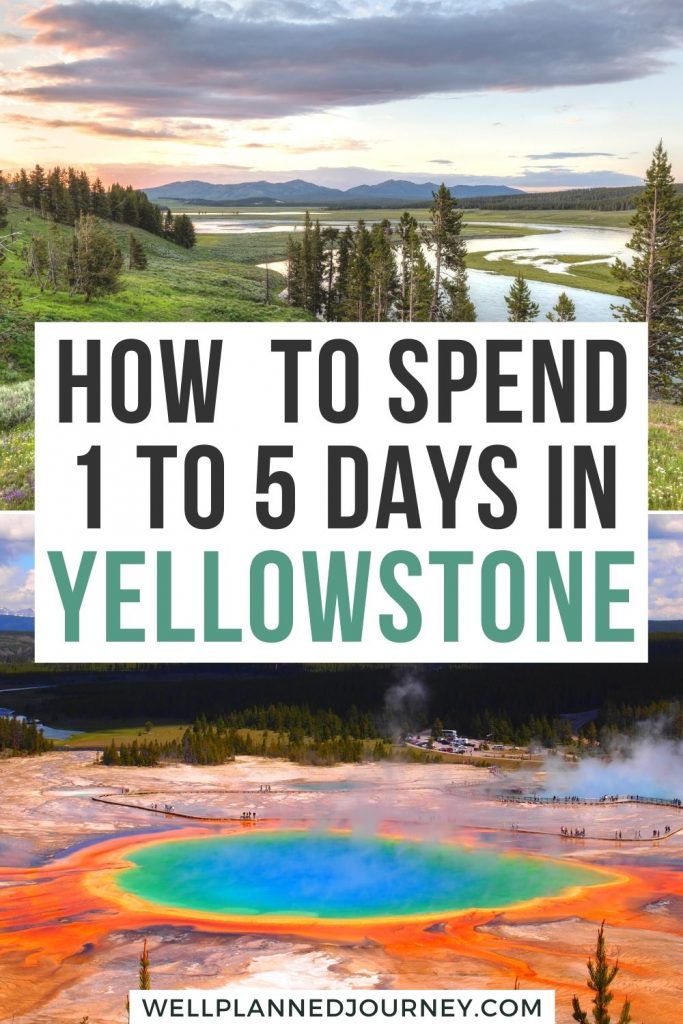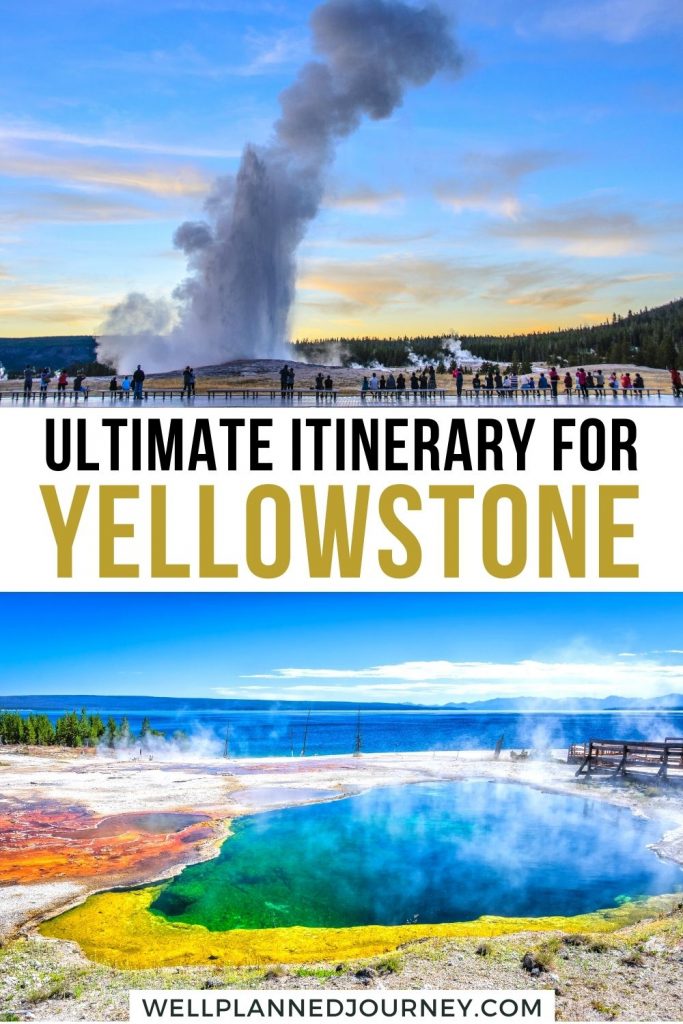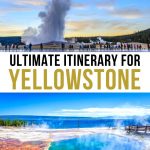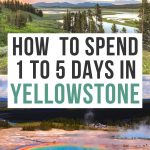Planning a trip to Yellowstone National Park can be overwhelming due to the park’s massive size and plentiful attractions. With so much to see and do, figuring out how to make the most of your time can be a challenge.
I’m here to help! In this post, you’ll find detailed 1-day to 5-day itineraries perfect for exploring the best of Yellowstone. You’ll also find my top tips on the best time to visit, where to stay, and more!
Are you ready to plan an epic Yellowstone National Park vacation, no matter how much time you have? Let’s get started!
This post may contain affiliate links, where I may receive a small commission at no additional cost to you. Read more in this disclosure policy.
Quick Overview of Yellowstone’s Regions
Before diving into the itinerary, it’s important to understand how Yellowstone is laid out.
Yellowstone National Park spans over 2 million acres across Wyoming, Idaho, and Montana. The park’s main attractions and entrances are connected by Grand Loop Road, a scenic highway forming a “Figure 8.”
There are five park entrances:
- West Entrance (West Yellowstone, MT): Best option for most park visitors or flying into West Yellowstone
- North Entrance (Gardiner, MT): Best for the northern part of the park, flying into Bozeman, and year-round access.
- Northeast Entrance (Cooke City, MT): Best for Lamar Valley and Beartooth Highway and flying into Billings
- East Entrance (near Cody, WY): Best for Yellowstone Lake and flying into Cody
- South Entrance (near Moran, WY): Best for visiting Grand Teton or flying into Jackson Hole
Read More: Where to Fly Into for Yellowstone
Due to the park’s size, it is important to plan your itinerary to visit geographically close regions on the same day to avoid spending hours in the car.
- With One or Two Days: Prioritize the southern, lower loop, including Old Faithful and Canyon Village.
- With More Than Two Days: Add the northern, upper loop, including Mammoth Hot Springs and Lamar Valley.
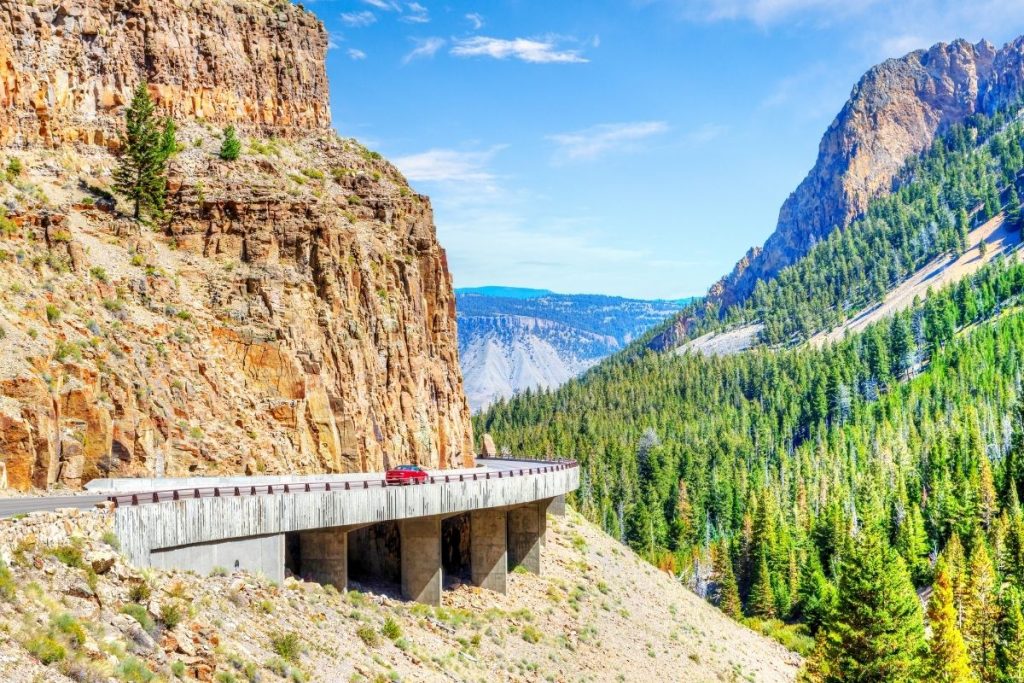
How Many Days Do You Need in Yellowstone National Park?
Plan to spend at least 2 to 3 days in Yellowstone to see the main attractions. With more time, you’ll be able to explore the park more fully and visit a few off-the-beaten-path destinations.
That said, this guide covers itineraries ranging from 1 to 5 days to give you the most flexibility.
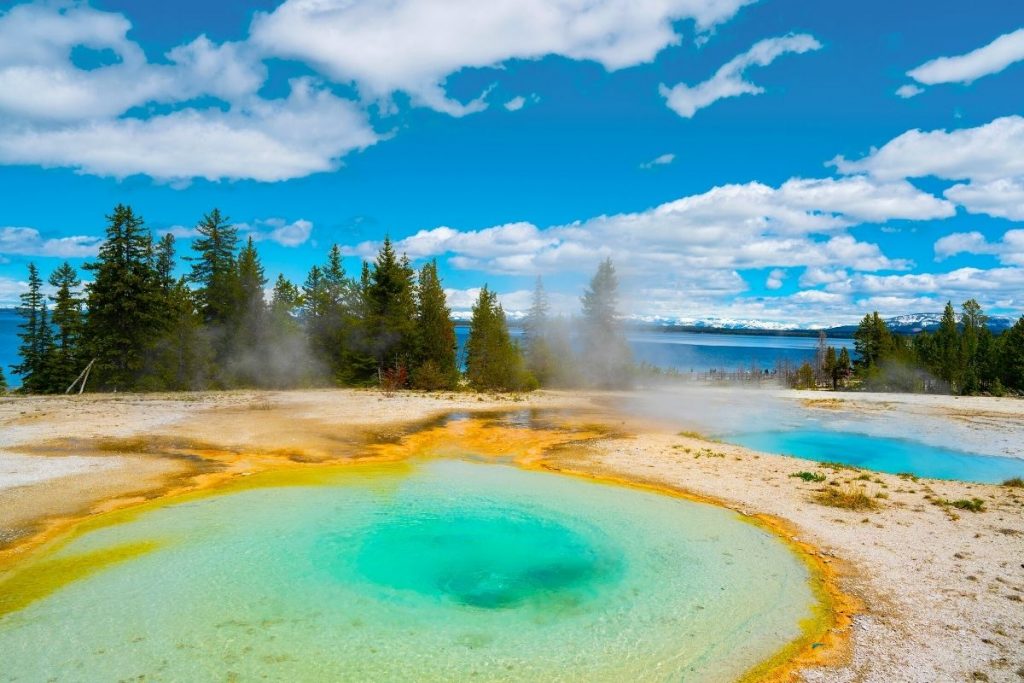
Best Time to Visit Yellowstone National Park
Summer is the best time to visit Yellowstone, with warm weather and all trails, roads, and amenities open. However, this is also the most crowded time of year.
For fewer crowds, visit in May or from September to mid-October. Much of the park is closed from November to April, so only visit this time of year for winter sports or snow tours.
Read more about seasonal closures in Yellowstone.
At-A-Glance: Yellowstone Itinerary Overview
One Day: Old Faithful and the Upper Geyser Basin, Grand Prismatic Overlook, Grand Canyon of the Yellowstone, Hayden Valley
Two or Three Days: If only visiting for two days, skip the third day listed below.
- Day One: Old Faithful and the Upper Geyser Basin, Grand Prismatic Overlook, Midway Geyser Basin, Firehole Canyon, Norris Geyser Basin
- Day Two: Hayden Valley, Grand Canyon of the Yellowstone, Mud Volcano, Storm Point Trail, West Thumb Geyser Basin
- Day Three: Mammoth Hot Springs, Tower-Roosevelt, Lamar Valley
Four or Five: With 4+ days, you’ll totally restructure your time in the park to see more in each area.
- Day One: Old Faithful and the Upper Geyser Basin, Grand Prismatic Overlook, Midway Geyser Basin, Lower Geyser Basin, Firehole Canyon
- Day Two: Hayden Valley, Grand Canyon of the Yellowstone, Mud Volcano, Storm Point Trail, West Thumb Geyser Basin
- Day Three: Mount Washburn, Tower-Roosevelt, Lamar Valley
- Day Four: Norris Geyser Basin, Mammoth Hot Springs
- Day Five: Beaver Ponds Loop and Boiling River Hot Springs or Beartooth Highway
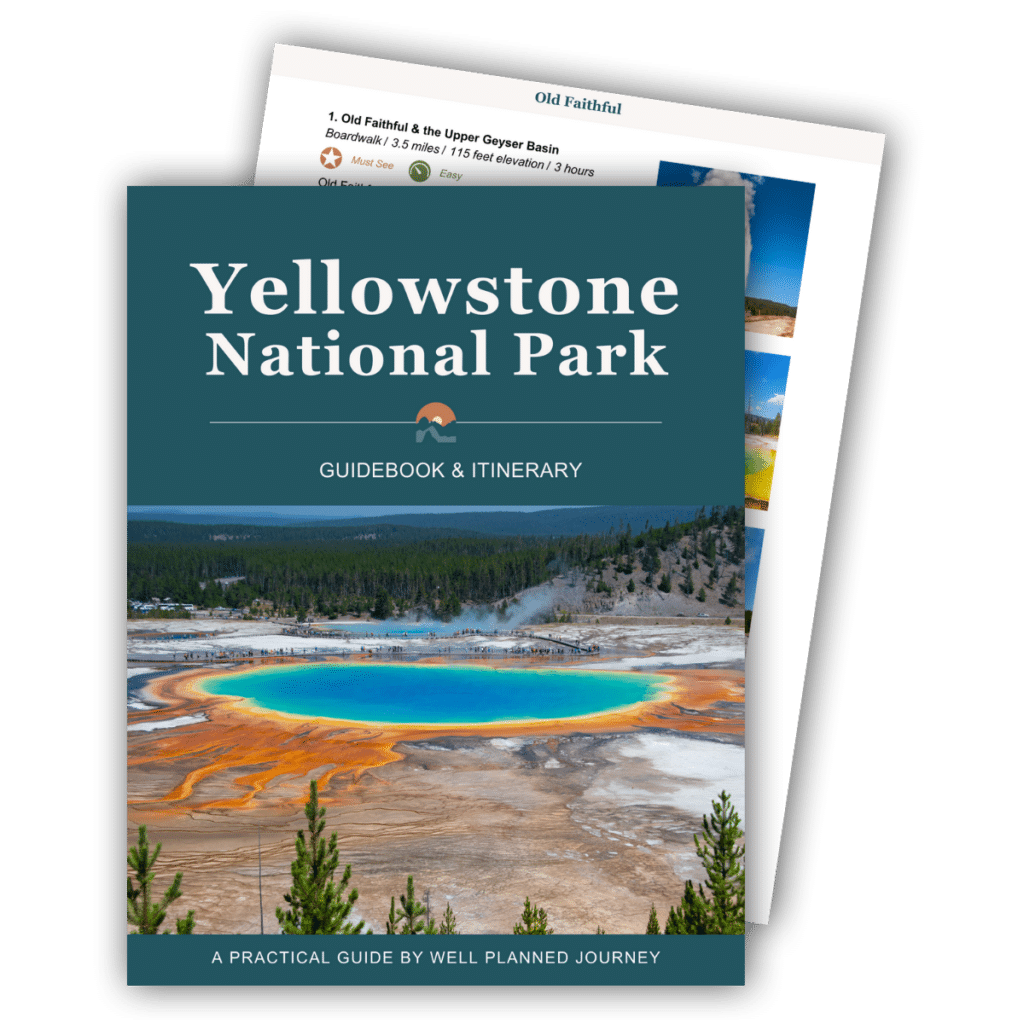
Get the Yellowstone Itinerary & Guidebook
The step-by-step itinerary and ultimate guidebook covers all the must-see geysers, hot springs, hikes, and sights. This 87-page guide is filled with detailed itineraries, insider tips, maps, regional overviews, and more for planning a stress-free trip to Yellowstone!
One Day in Yellowstone National Park
If you only have one day in Yellowstone, focus on the most iconic spots.
Start in the Old Faithful area, exploring Old Faithful and Upper Geyser Basin. Next, visit Grand Prismatic Spring, followed by the Grand Canyon of the Yellowstone. End your day with a drive through Hayden Valley to see wildlife.
Morning: Old Faithful and Upper Geyser Basin.
Start your day early at Old Faithful, which erupts every 1.5 hours. Check the geyser prediction schedule the night before to determine when to arrive. After catching the Old Faithful eruption from the viewing area, explore the rest of the Upper Geyser Basin. Don’t miss Grand Riverside Geyser, Chromatic Pool, and Morning Glory Pool! Finally, end your time here at the Old Faithful Inn and Visitor Center.
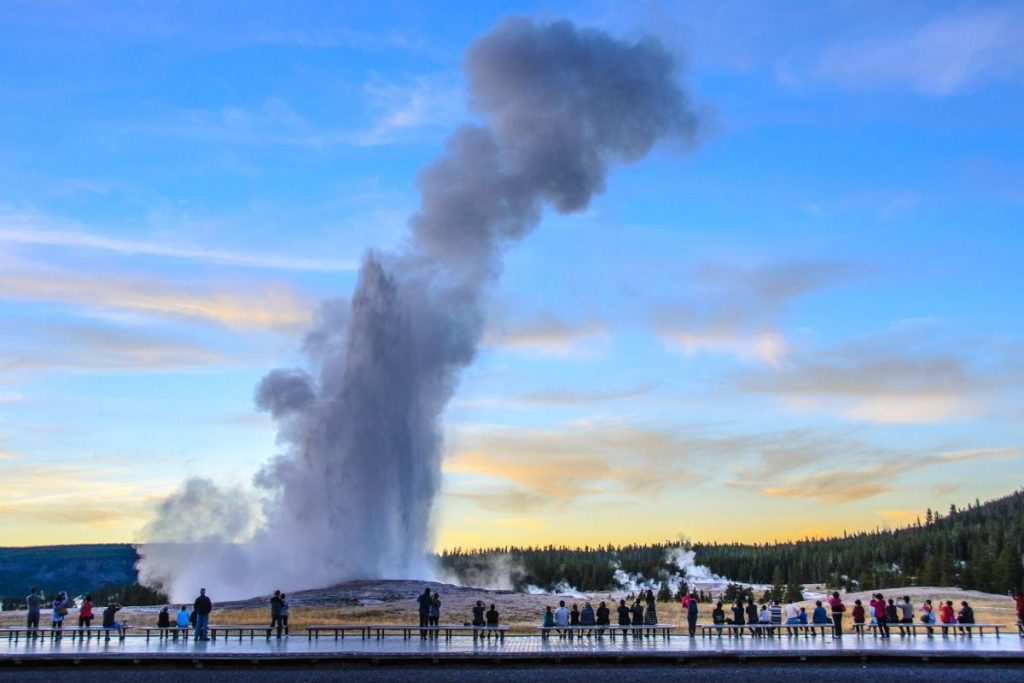
Early Afternoon: Grand Prismatic Spring Overlook. Only a short drive from Old Faithful, you’ll find the second most famous landmark. However, the best way to see the geyser is from above via the Fairy Falls Trail. This 1.5-mile hike is relatively easy and provides fantastic views. If you aren’t up for the hike, you can also see Grand Prismatic via the accessible boardwalks in the Midway Geyser Basin.
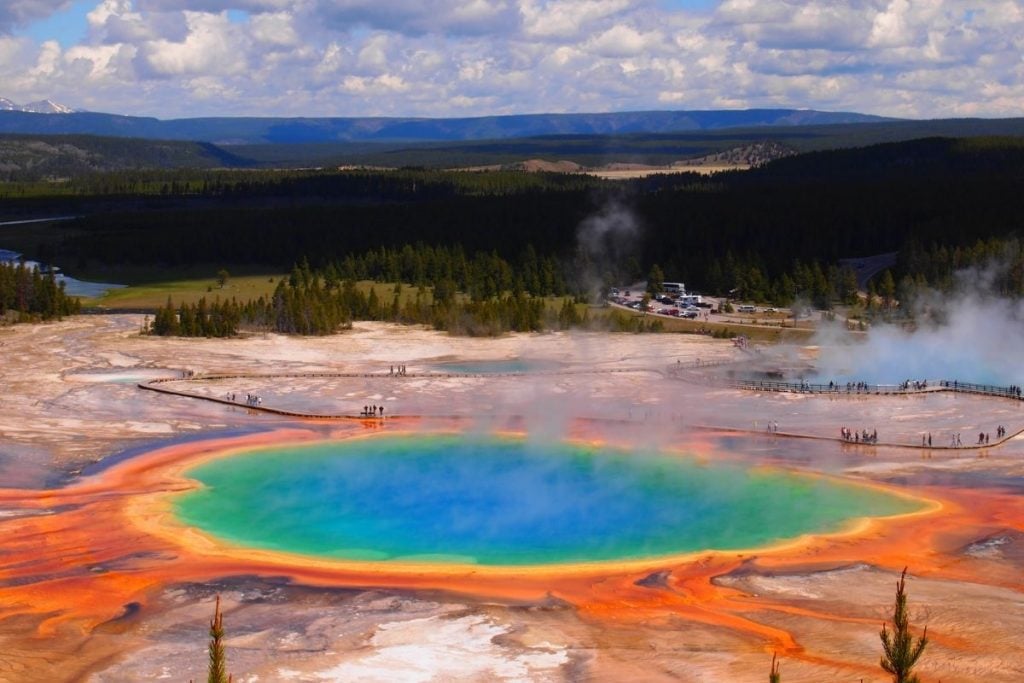
Late Afternoon: Grand Canyon of the Yellowstone. After you’ve had your fill of geysers and springs, head across Grand Loop Road to the Grand Canyon of the Yellowstone. Drive the South Rim road to Artist Point for excellent views of the canyon and Lower Falls. Drive the North Rim, too, stopping at Lookout Point if you have time.
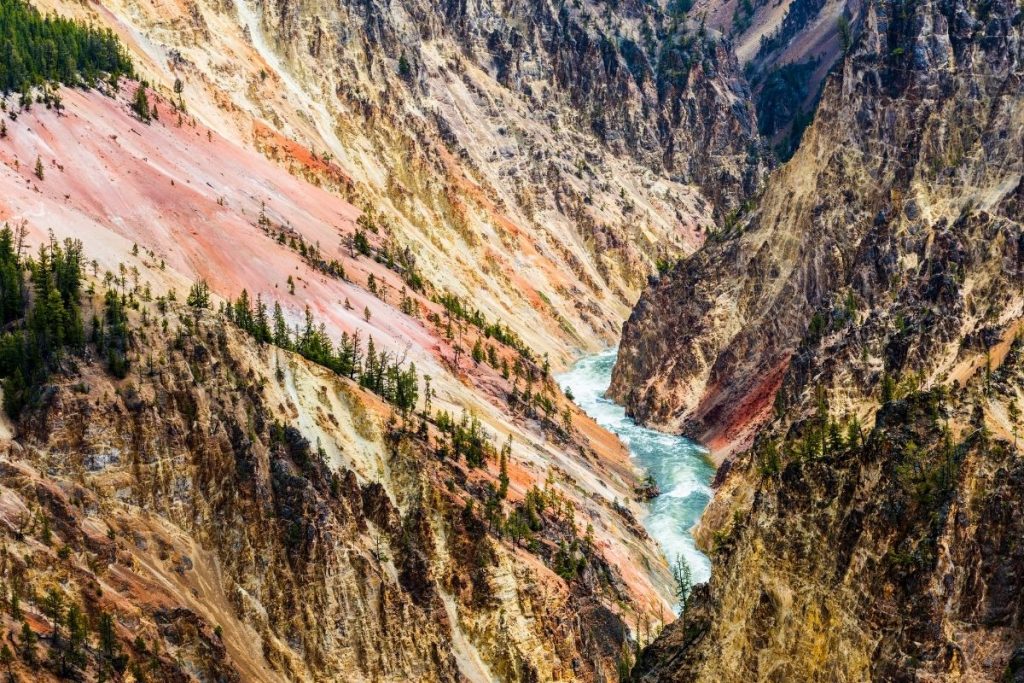
Evening: Hayden Valley. End your day in Yellowstone with Hayden Valley, an excellent destination to spot wildlife. Drive through the valley and find a spot to sit and watch for animals. Expect to see plenty of bison. If you’re lucky, you may also spot elk, moose, grizzly bears, and bald eagles!

Where to Stay: Canyon Village. The most convenient place to stay is at Canyon Lodge or Canyon Campground. If you’re staying outside the park, the closest place to stay is in West Yellowstone, about 1 hour away.
2 or 3 Day Yellowstone Itinerary
With two days in Yellowstone, you’ll explore the same destinations as in the one-day itinerary but at a more leisurely pace. I highly recommend spending two days in Yellowstone instead of one day to avoid feeling overwhelmed.
If you have 3 days in the park, keep days 1 and 2 the same and add “Day 3”.
Day 1: Old Faithful, Upper Geyser Basin, & Grand Prismatic Spring
Morning: Old Faithful and Upper Geyser Basin. Start your day early at Old Faithful, which erupts every 1.5 hours. Check the geyser prediction schedule the night before to determine when to arrive. After catching the Old Faithful eruption from the viewing area, explore the rest of the Upper Geyser Basin for at least 2 hours. Don’t miss Grand Riverside Geyser, Chromatic Pool, and Morning Glory Pool!
End your time here at the Old Faithful Inn (you can watch Old Faithful erupt from the lodge’s deck!) and explore the displays at the visitor center.
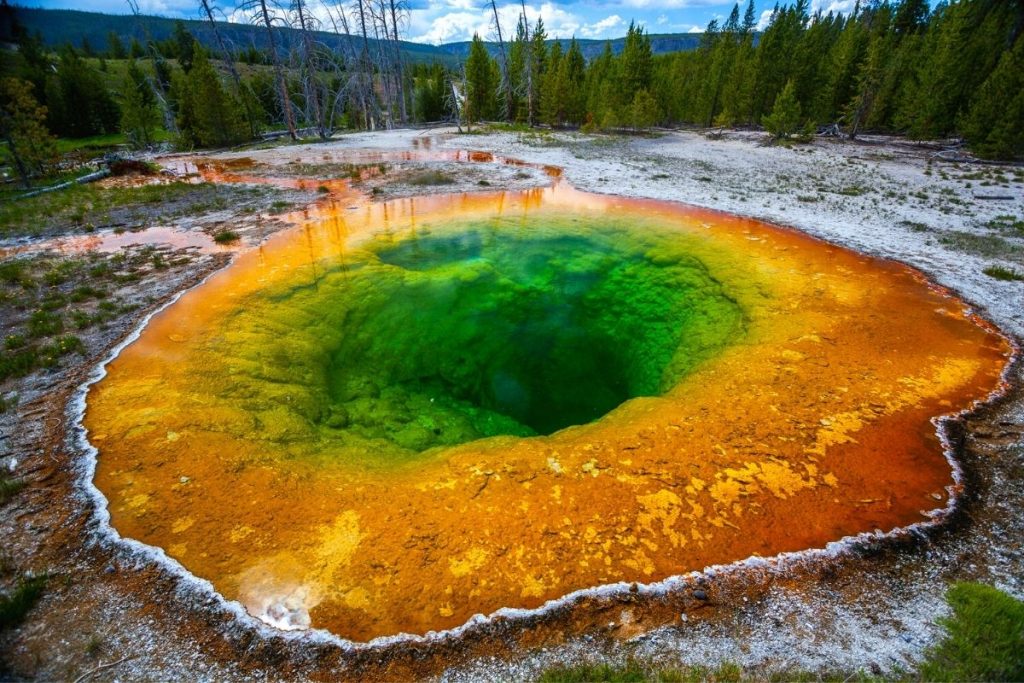
Early Afternoon: Grand Prismatic Spring Overlook and Midway Geyser Basin. Continue a few miles along Grand Loop Road to the Fairy Falls Trailhead. This 1.5-mile hike allows you to see Grand Prismatic Spring from above. After seeing Grand Prismatic from above, you can get an up-close look by walking the Midway Geyser Basin. This route is more accessible and better for those unable to hike to the overlook.
Read More: 15 Best Hikes in Yellowstone National Park
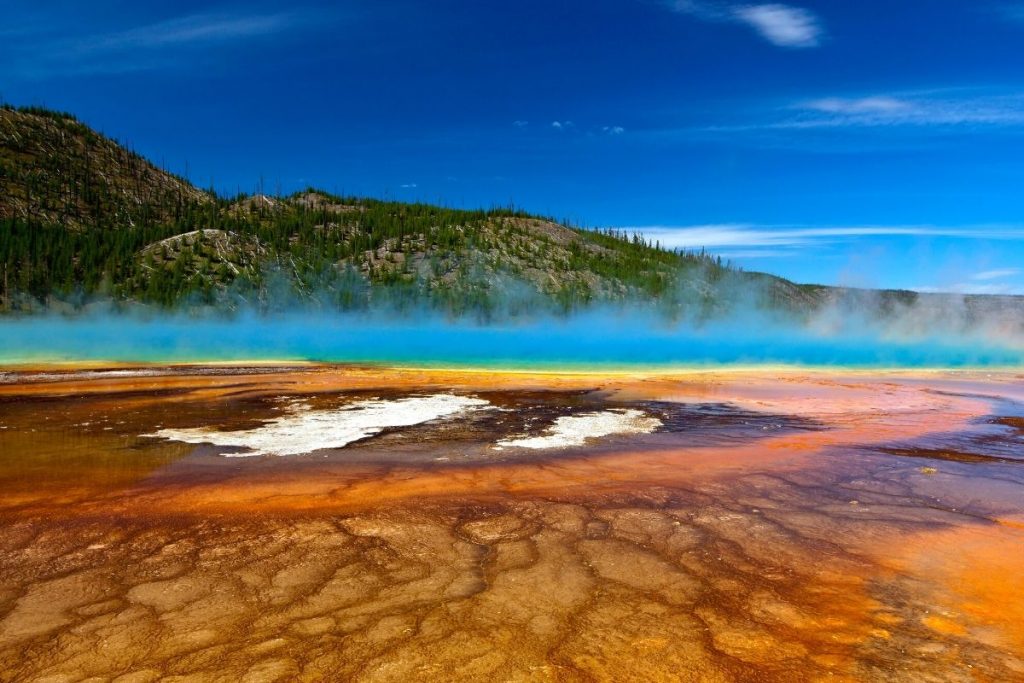
Late Afternoon: Firehole Canyon and Norris Geyser Basin. Next, head north to Firehole Canyon Road, a 7.5-mile scenic drive featuring a 40-foot roadside waterfall and a swimming area. End your day by visiting the Norris Geyser Basin. It is made up of two loops: Porcelain Basin and Back Basin, both of which are worth exploring.
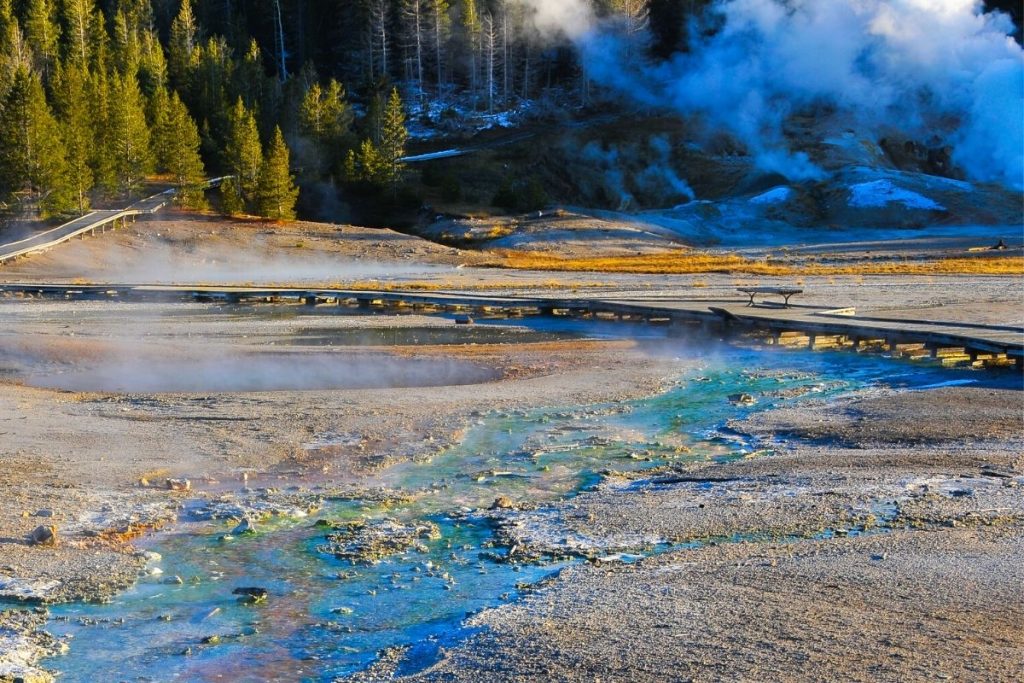
Where to Stay: Canyon Village. The most convenient place to stay is Canyon Lodge or Canyon Campground. However, Norris or Madison Campgrounds make good alternatives too. If you’re staying outside the park, the closest place to stay is in West Yellowstone, about 45 minutes away.
Read More: Best Places to Stay in Yellowstone National Park
Day 2: Grand Canyon of the Yellowstone & Yellowstone Lake
Early Morning: Hayden Valley. Start your second day in Yellowstone with a scenic drive through Hayden Valley. Keep your eyes peeled for any wildlife (most likely bison). Morning is one of my favorite times to drive through Hayden Valley as a stark contrast in temperature from the air and hydrothermal features creates mystical steam.
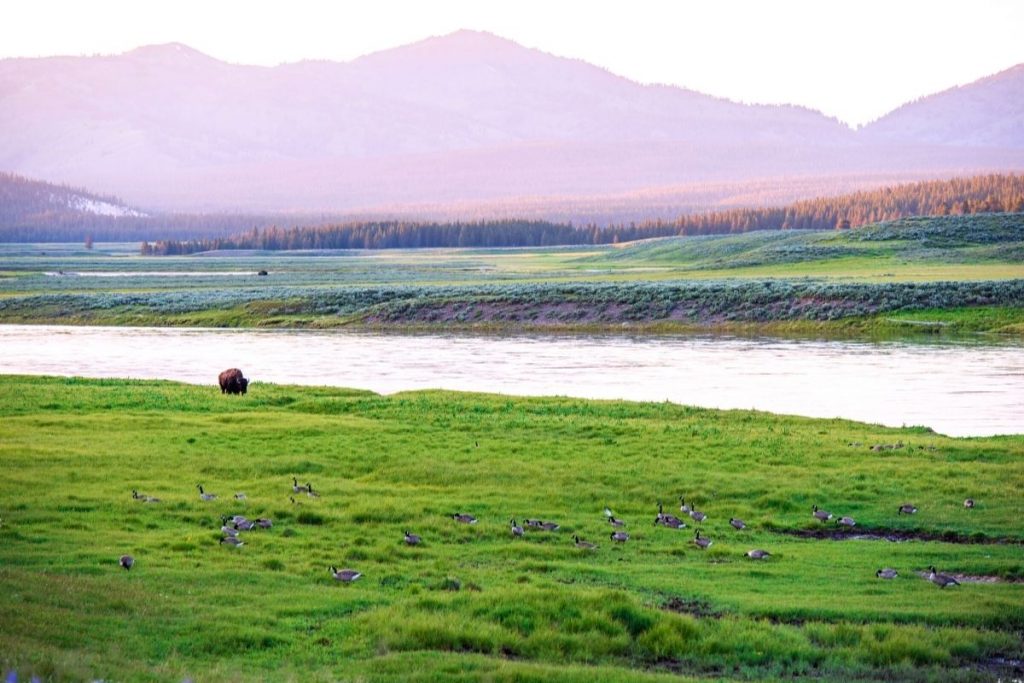
Mid Morning: Grand Canyon of the Yellowstone. Head to the South Rim of the Grand Canyon of the Yellowstone first. Don’t miss Artist Point and Upper Falls Viewpoint. Next, head to the North Rim. It’s a one-way drive through the North Rim, so I recommend stopping at the viewpoints in order. Don’t miss Lookout Point, Grand View, and Inspiration Point. Also, try the steep Brink of the Lower Falls or Red Rock Point trails if you want to hike.
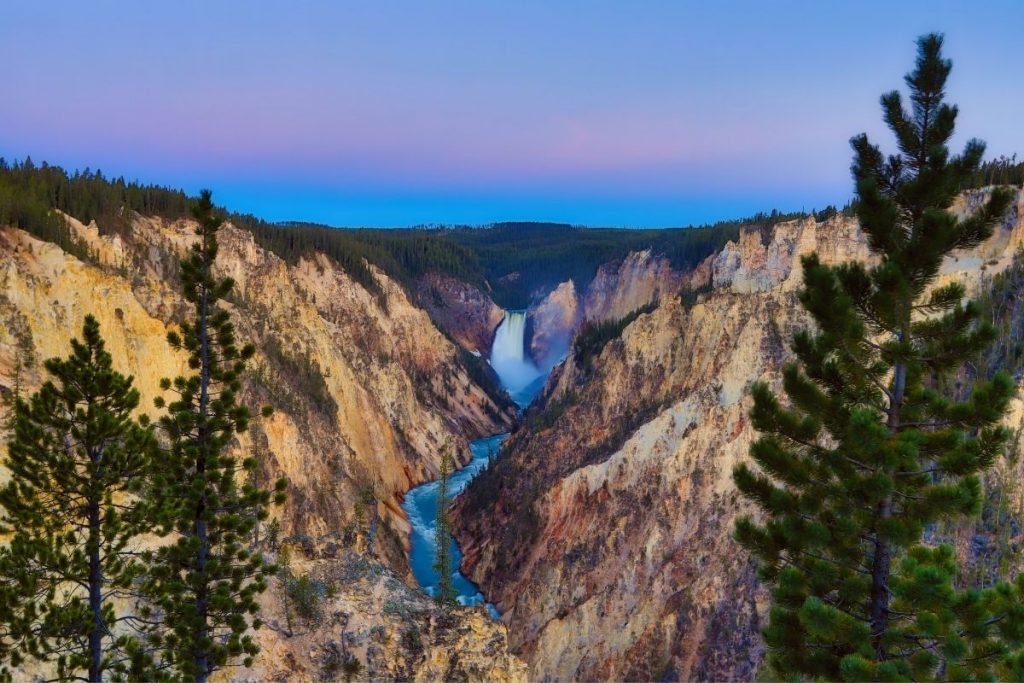
Early Afternoon: Mud Volcano and Yellowstone Lake. Continue south through Hayden Valley until you reach Mud Volcano, a small geothermal area filled with gurgling and steaming features. Then, head further south towards Yellowstone Lake. If you’re up for a hike, explore the 2.5-mile Storm Point Trail for beautiful views along the lake shore.
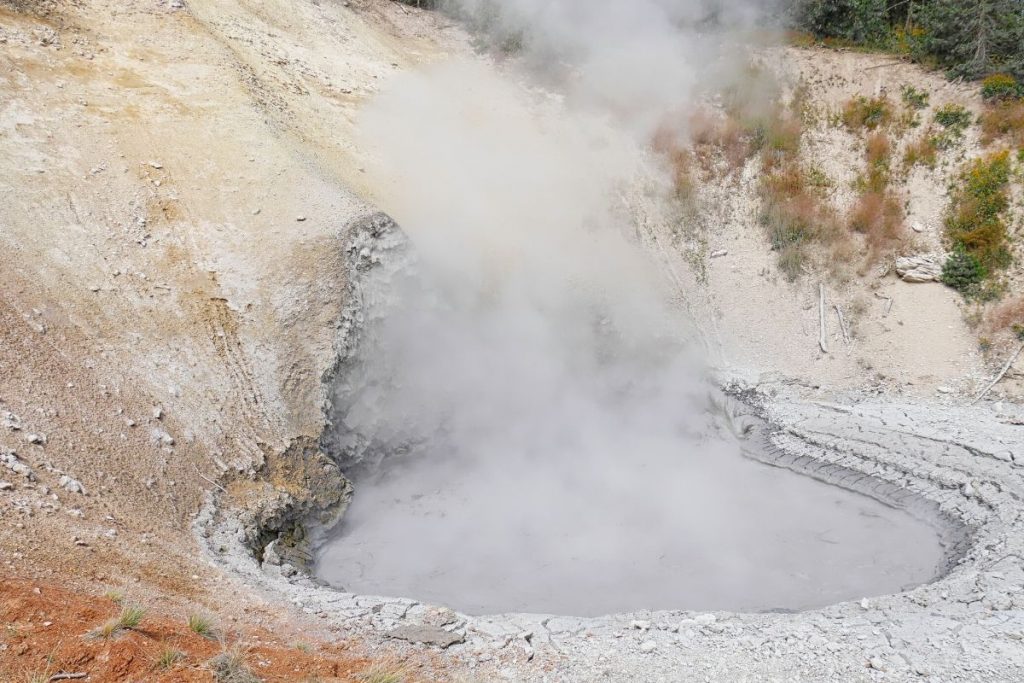
Late Afternoon: West Thumb Geyser Basin. If you have some time, visit Lake Yellowstone Hotel on your way to West Thumb. Located on the shores of Yellowstone Lake, this is one of my favorite geyser basins! Don’t miss Abyss Pool, Fishing Cone, and Black Pool.
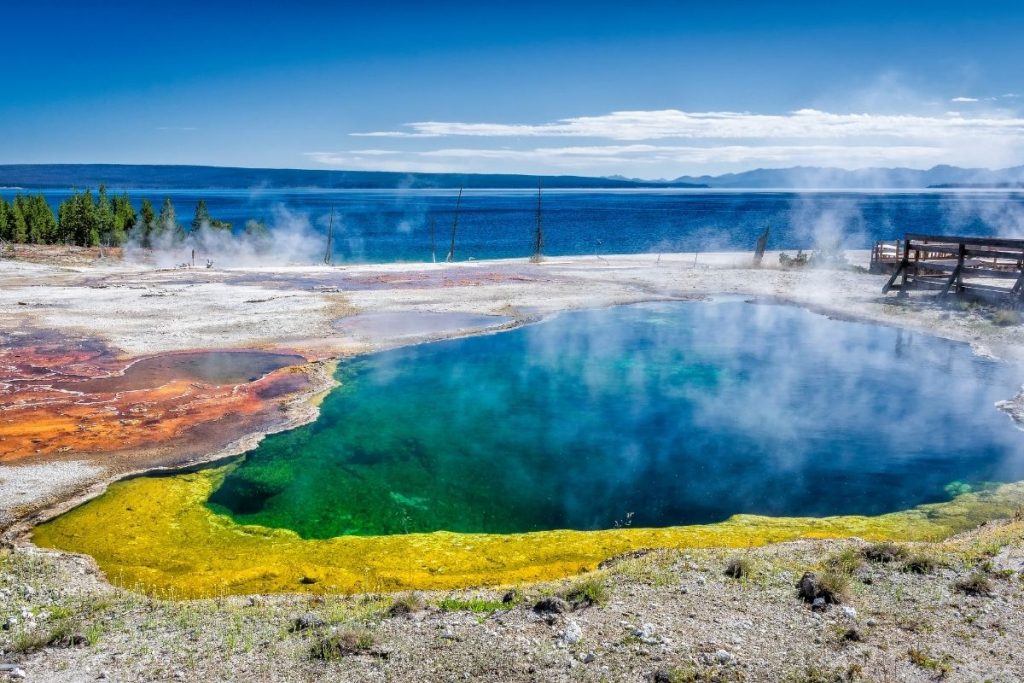
Where to Stay: Grant Village or Canyon Village. Grant Village is the closest option, but for simplicity, I recommend staying at the same place as your first night (Canyon Village or West Yellowstone). If you’re heading to Grand Teton next, spending the night there instead.
Day 3: Mammoth Hot Springs & Lamar Valley
Morning: Mammoth Hot Springs. This geothermal area is made up of a Lower and Upper Terrace. I recommend walking through the Lower Terrace and driving through the Upper Terrace. After seeing Mammoth Hot Springs, walk through the town, checking out the Albright Visitor Center and historic Fort Yellowstone.
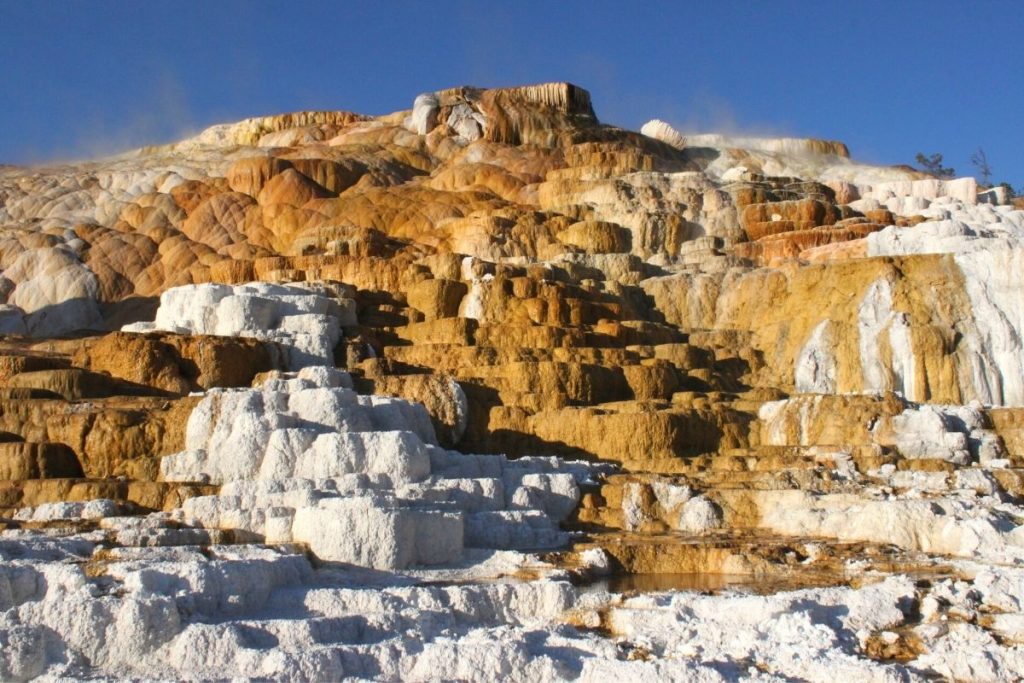
Afternoon: Tower-Roosevelt. Leave Mammoth heading east on Grand Loop Road to Tower-Roosevelt. A few miles south of Tower Junction, you’ll find Tower Fall, a scenic viewpoint overlooking the waterfall. For a short but challenging hike, continue on the switchbacks past the viewpoint for an overlook of Yellowstone River.
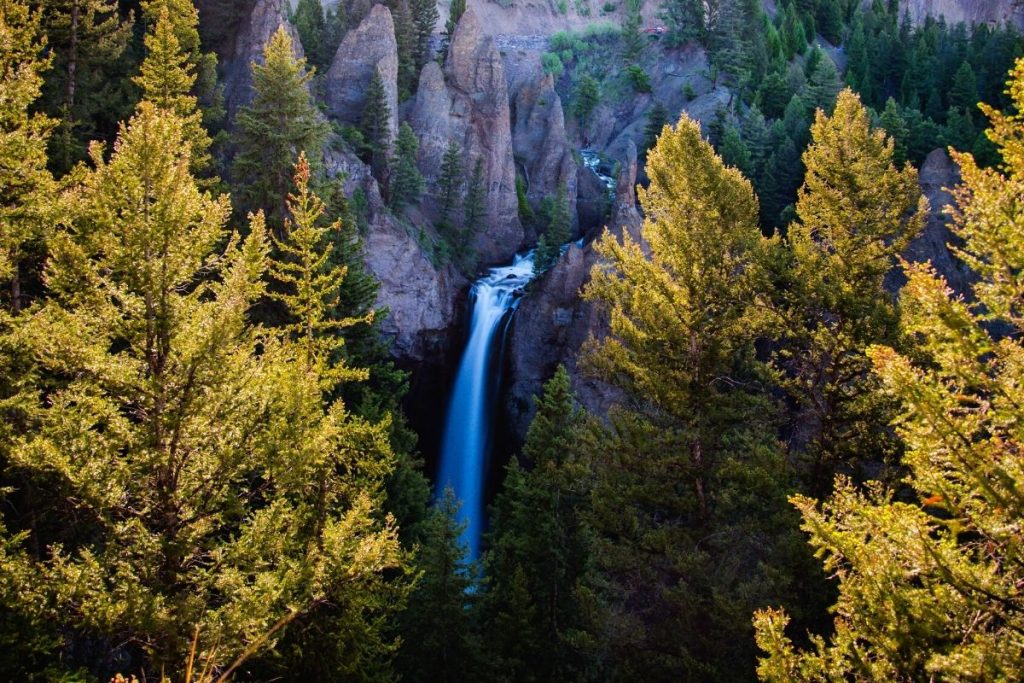
Late Afternoon: Lamar Valley. End your day with wildlife watching in Lamar Valley, one of the premier wildlife destinations in the park. Keep your eyes peeled for bison, bears, coyotes, and even wolves! If you stick around after sunset, you may hear wolves howling in the distance. Don’t forget your binoculars as the wildlife might be far away.
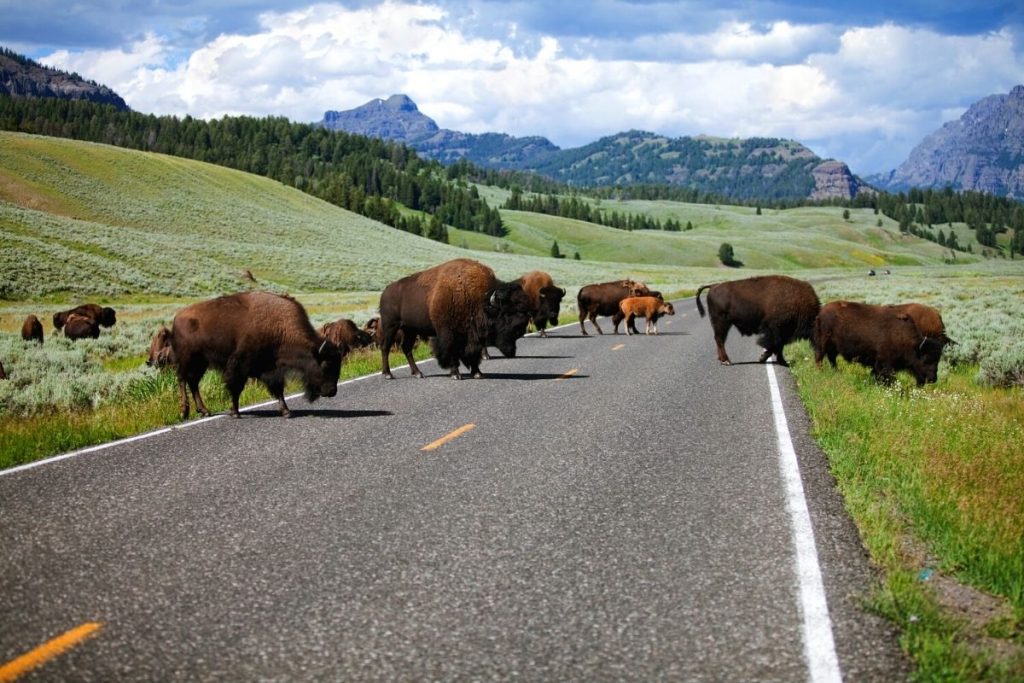
Where to Stay: Canyon Village or Gardiner. If you stayed in Canyon Village the past few nights, stay here for your final night as well. If you stayed outside the park in West Yellowstone, I recommend relocating to spend one night in Gardiner.
4 or 5 Day Yellowstone Itinerary
In my opinion, four days in Yellowstone National Park is the perfect amount of time to see all the top attractions and the best things to do.
To avoid repetitiveness, I’ve outlined the itinerary below instead of repeating all the details. You can read the descriptions of repeated activities in the 1-3 day itineraries above! New additions are called out below.
Day 1: Old Faithful, Upper Geyser Basin, & Grand Prismatic Spring
- Morning: Old Faithful and Upper Geyser Basin
- Early Afternoon: Black Sand Basin and Biscuit Basin
- Mid Afternoon: Grand Prismatic Spring Overlook and Midway Geyser Basin
- Late Afternoon: Fountain Paint Pots, Firehole Canyon Drive,
- Where to Stay: Canyon Village or West Yellowstone
New for the 4-Day Itinerary: Fountain Paint Pots. Located in the Lower Geyser Basin, this area is much less busy compared to the Upper and Midway Geyser Basins. The 0.6-mile is a quick activity to explore off-the-beaten-path.
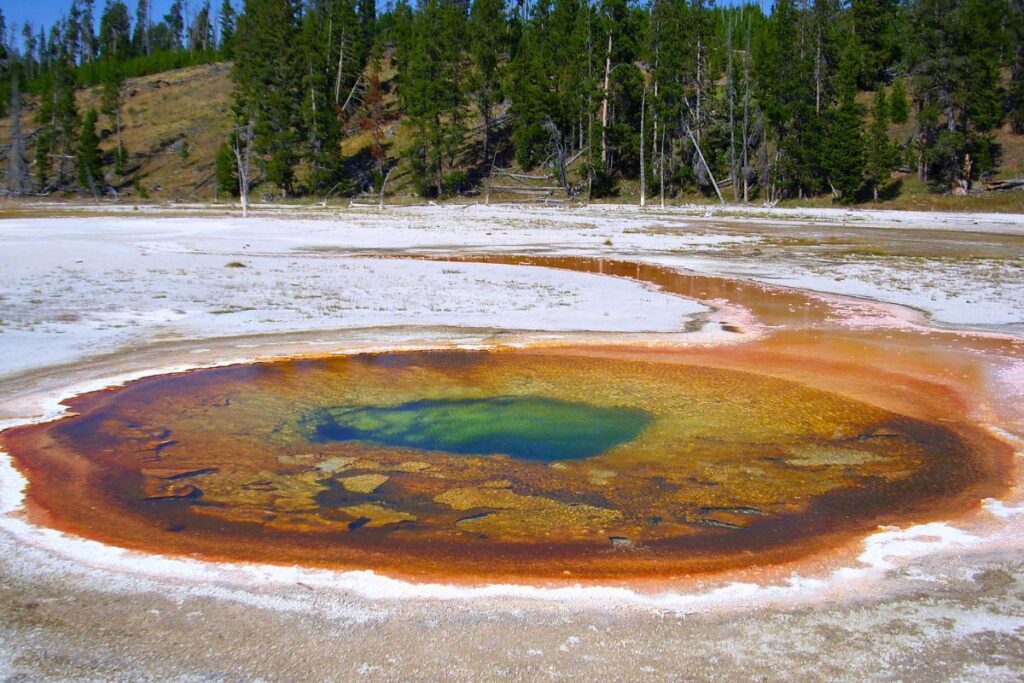
Day 2: Grand Canyon of the Yellowstone & Yellowstone Lake
- Early Morning: Hayden Valley
- Mid Morning: Grand Canyon of the Yellowstone
- Early Afternoon: Mud Volcano and Storm Point Trail
- Late Afternoon: West Thumb Geyser Basin
- Where to Stay: Canyon Village or West Yellowstone
Day 3: Tower-Roosevelt & Lamar Valley
- Morning: Mount Washburn Trail via Dunraven Pass
- Early Afternoon: Tower Fall and Calcite Springs Overlook
- Late Afternoon: Lamar Valley
- Where to Stay: Canyon Village or Gardiner
New for the 4-Day Itinerary: Mount Washburn Trail. This incredible panoramic trail is routinely rated as one of the top hikes in Yellowstone. The 6.8-mile hike starts at Dunraven Pass and takes you to the summit of Mount Washburn, standing at 10,200 feet.
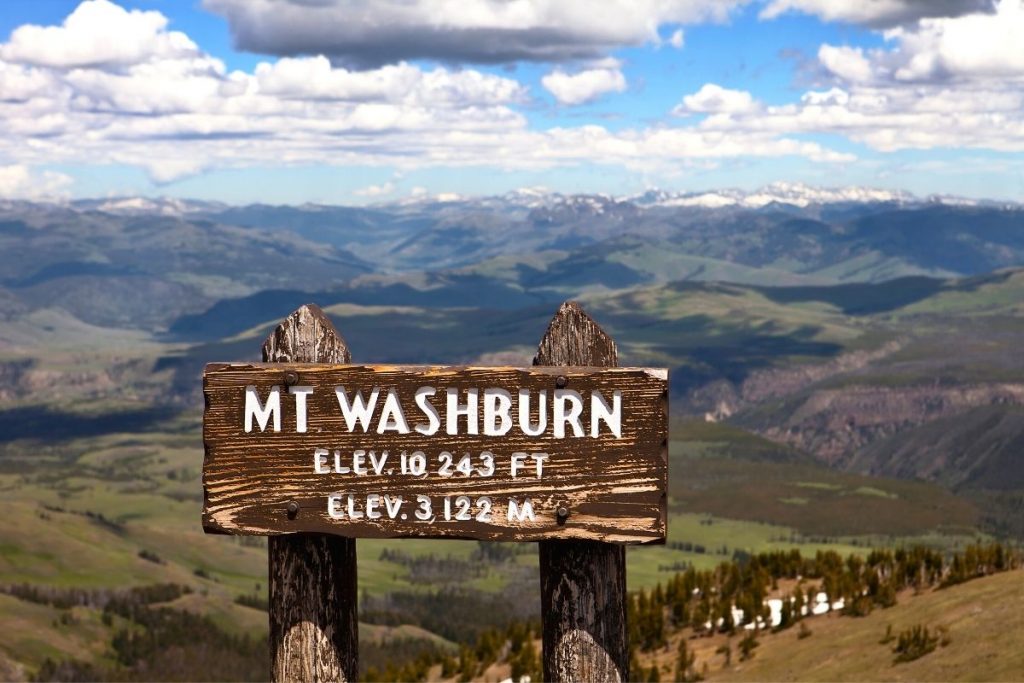
Day 4: Norris Geyser Basin & Mammoth Hot Springs
- Morning: Norris Geyser Basin
- Early Afternoon: Mammoth Hot Springs
- Late Afternoon: Roosevelt Arch & Boiling River Hot Springs
- Where to Stay: Mammoth Hot Springs or Gardiner
New for the 4-Day Itinerary: Roosevelt Arch & Boiling River Hot Springs. This monument was built to honor Teddy Roosevelt, one of the pioneers of the national park system. In the early days of the park, Gardiner was the primary way to enter the park, with most visitors passing through Roosevelt Arch to enter. End your time in Yellowstone with a swim in the Boiling River Hot Springs swimming area just outside of Gardiner.
Note: Boiling River is currently closed due to 2022 flooding. Dine out in Gardiner to end your day instead!
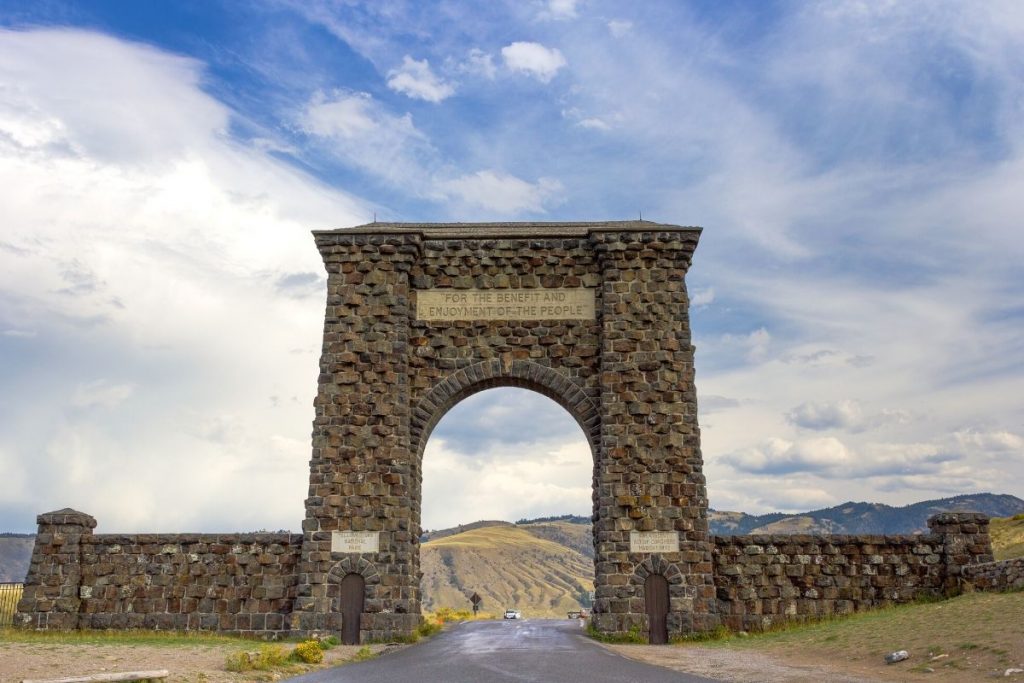
Day 5: Beartooth Highway or Beaver Ponds Trail
If you have five days in the park, add on one of these additional activities to the four day itinerary above!
- Drive Beartooth Highway. This scenic drive just outside the Northeast entrance of Yellowstone is rated as one of the best in the United States. While technically not located in Yellowstone, it’s an excellent way to end your time here. However, the highway is typically only open from late May to mid-October.
- Hike Beaver Ponds Loop Trail. If you want to stay in the Mammoth area, spend the morning hiking Beaver Pond Loop. This easy 5-mile trail provides excellent opportunities for spotting wildlife in the Mammoth Hot Springs area. In the afternoon, head back out to Lamar Valley to look for more wildlife.
Where to Stay: Mammoth Hot Springs or Gardiner
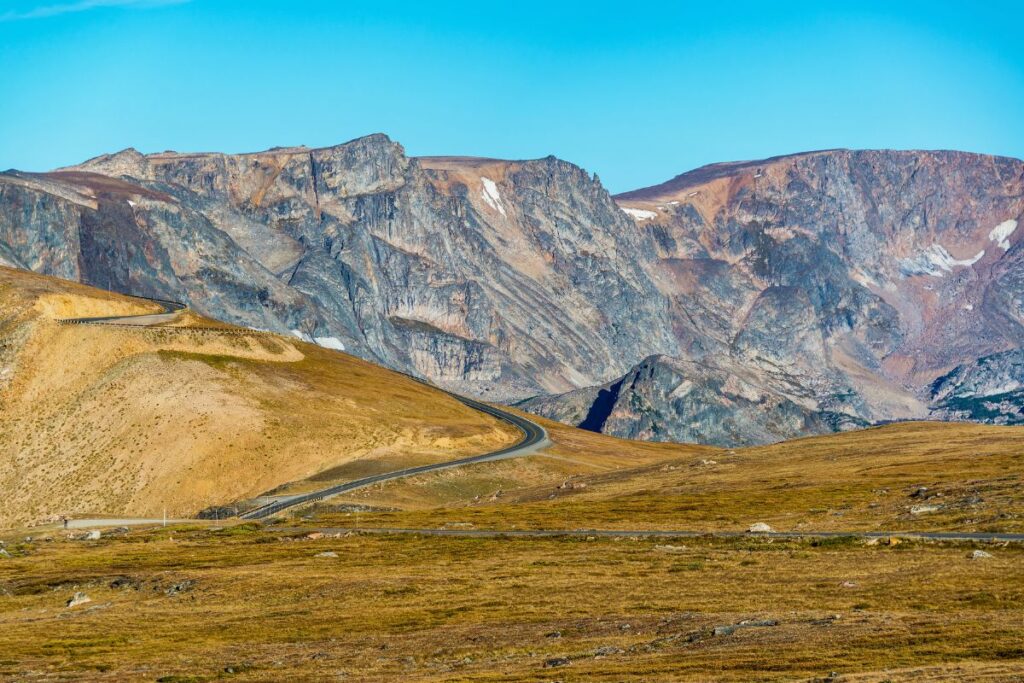
If You Have More Time in Yellowstone
If you have more than five days to spend in Yellowstone, I highly recommend checking out more of the best things to do! Here are some ideas:
- Hike the Fairy Falls Trail
- Drive Firehole Lake Drive and see Great Fountain Geyser erupt
- Conquer the challenging Avalanche Peak Trail near Yellowstone Lake
- Drive the scenic Blacktail Plateau Drive near Mammoth
- Go on the Old West Dinner Cookout
- Hike the North Rim Trail or South Rim Trail at the Grand Canyon of the Yellowstone
- Hike or bike the Lone Star Geyser Trail
- Walk the Artist Paint Pots Trail
Are you looking for more activities in Yellowstone? Check out these posts on the best things to do in Yellowstone and the best hikes in Yellowstone.
Where to Stay In and Near Yellowstone
I highly recommend staying inside the park, if possible, to cut down on driving time. However, this requires booking about a year in advance. If you are planning your trip less than six months in advance, your best bet will be staying outside the park in nearby towns.
In the itinerary section above, I mention the areas to stay each night based on the region you’ll explore each day.
Here are the lodges and campgrounds I recommend inside the park:
- Canyon Village: Canyon Lodge & Cabins or Canyon Campground
- Mammoth Hot Springs: Mammoth Hot Springs Hotel & Cabins or Mammoth Campground
To find lodging outside the park in West Yellowstone or Gardiner, I recommend using this interactive map to help you search all the available hotels and rental properties near the park. Simply scroll and click the map below to see what is available!
Looking for more tips on where to stay for your trip to Yellowstone? Check out these guides on the Best Lodges & Hotels Near Yellowstone and best campgrounds in Yellowstone.
Tips for Planning a Trip to Yellowstone
- Book lodging as soon as possible. Lodges inside the park release reservations 13 months in advance. All campgrounds in Yellowstone now require a reservation, which are released 6-13 months ahead depending on the campground. Aim to book hotels outside the park at least six months out.
- Get a national park pass in advance. If you’re planning on visiting multiple national parks in the next year, you’ll save money by getting a national park pass. Purchasing it in advance saves you time at the busy Yellowstone entrance stations. Get your America the Beautiful Pass now for only $80.
- Start your day early to avoid crowds. By 10 AM, parking lots are full, and trails are crowded. After 4 PM, crowds tend to clear out too, so early evening until sunset is also a great time to explore!
- Pack plenty of layers. Even in the summer, overnight and morning temperatures are near freezing. Dressing in layers is critical. I recommend packing fleeces and down layers, plus a warm hat and gloves.
- Pack binoculars. When looking for wildlife, a quality pair of binoculars helps you see them from a safe distance. In areas like Hayden Valley and Lamar Valley, binoculars are crucial as you’re often looking at animals off in the distance.
- Keep your distance from wildlife. Stay 25 yards away from bison, female elk, deer, and moose. You should stay 100 yards away from more aggressive animals like bears, wolves, and bull elk during rutting season.
- Always carry bear spray when hiking. If you’re driving to Yellowstone, I recommend buying bear spray ahead of time. If you are flying to Yellowstone, you can buy it locally from any sporting goods store or rent it (you can’t fly with bear spray, even in a checked bag!).
- Check road conditions before your trip. The best way to stay up to date on road closures for weather or construction, as well as trail status for wildlife activity, is on the Yellowstone National Park website.
- Take the first day to acclimate to the elevation. The Yellowstone Caldera is located above 9,000 feet. For most visitors, it will take a few days to acclimate to the elevation. I recommend saving your more strenuous activities for later on in your trip and spending the first few days doing scenic drives or easy hikes through the geyser basins.
- Cell phone service in Yellowstone is limited. Be sure to download all reservations, confirmations, and maps offline before entering the park. I like to save all information in an offline Dropbox or Google Drive folder and take a screenshot.
Looking for more tips on what to pack for your trip? Check out my guides on the best hiking gear, what to pack for a road trip, and essential camping gear for all my favorite gear picks and tips to make packing for your trip a breeze!
Frequently Asked Questions
How many days do you need in Yellowstone and Grand Teton?
To see the highlights of both Yellowstone and Grand Teton National Park, you’ll need at least 5 to 7 days. This gives you about three days in Yellowstone and two days in Grand Teton. To explore both parks further, I recommend ten days.
Is 3 days in Yellowstone enough?
Three days in Yellowstone is enough time to see all the highlights in the park without feeling rushed. You’ll be able to see top attractions like Old Faithful, Grand Prismatic, and Grand Canyon of the Yellowstone.
Is 5 days in Yellowstone enough?
Five days in Yellowstone provides enough time to see nearly everything Yellowstone offers. In 5 days, you can see top attractions, hike popular trails, and see plenty of wildlife and scenic drives.
How many days does it take to drive through Yellowstone?
To see all of Yellowstone, you’ll need at least 2 to 3 days to drive throughout the park. However, the Grand Loop Road connects all the park’s top attractions and allows you to navigate the park easily over several days.
Can you drive through Yellowstone in a day?
You can visit Yellowstone National Park in one day if you are only interested in seeing the top attractions. For example, in one day, you can see both Old Faithful and Grand Prismatic Spring, the most popular spots in Yellowstone.
Can you just drive through Yellowstone National Park?
Grand Loop Road connects all the entrances to Yellowstone. While you can drive directly through Yellowstone National Park, you will be required to pay the entry fee at the park entrance station.
Final Thoughts and Next Steps
I highly recommend spending at least two days in Yellowstone National Park. This gives you just enough time to explore the park’s top attractions without feeling too rushed.
Personally, my ideal Yellowstone itinerary is four days, as shown below:
- Day One: Old Faithful and the Upper Geyser Basin, Grand Prismatic Overlook, Midway Geyser Basin, Lower Geyser Basin, Firehole Canyon
- Day Two: Hayden Valley, Grand Canyon of the Yellowstone, Mud Volcano, Storm Point Trail, West Thumb Geyser Basin
- Day Three: Mount Washburn, Tower-Roosevelt, Lamar Valley
- Day Four: Norris Geyser Basin, Mammoth Hot Springs
I also highly recommend adding Grand Teton National Park to your trip. Located only 30 minutes south of Yellowstone National Park, it provides incredible scenery and hiking, plus plenty of wildlife.

Get the Yellowstone Itinerary & Guidebook
The step-by-step itinerary and ultimate guidebook covers all the must-see geysers, hot springs, hikes, and sights. This 87-page guide is filled with detailed itineraries, insider tips, maps, regional overviews, and more for planning a stress-free trip to Yellowstone!
Read these posts next:
- Add Grand Teton: 7-Day Yellowstone & Grand Teton Itinerary
- Road Trip: 8-Day Salt Lake to Yellowstone Road Trip
- Where to Stay: Best Hotels & Lodges Near Yellowstone
- Things to Do: 22 Best Things to Do in Yellowstone
Don’t Forget to Save This Post on Pinterest
